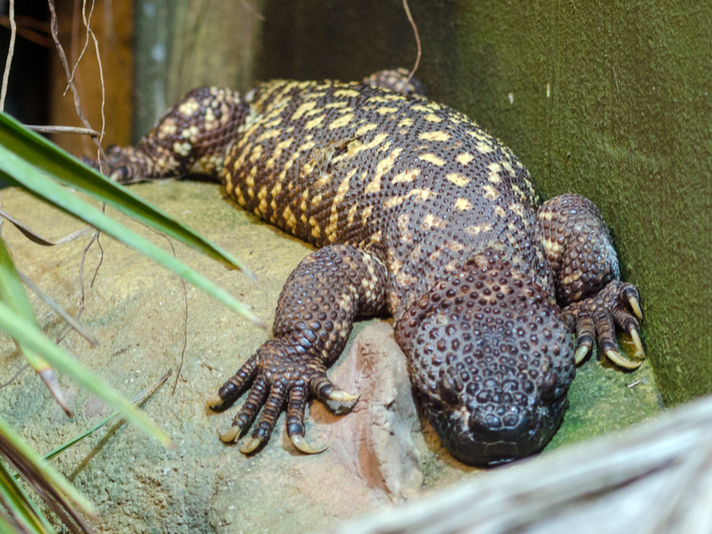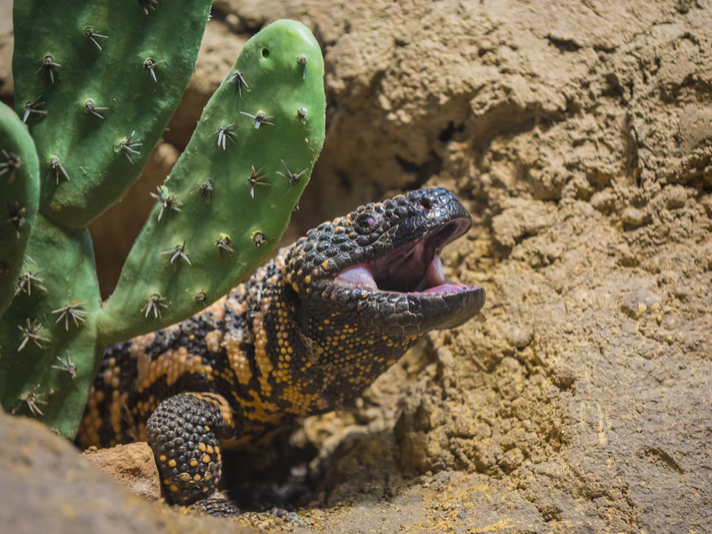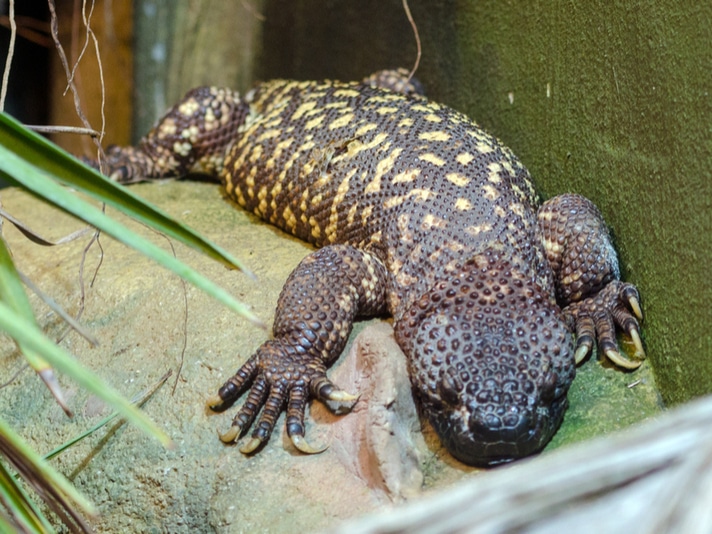With their exquisite beaded osteoderms, striking coloration and fat, forked tongues, beaded lizards and Gila monsters are among the most beautiful reptiles.
My first experience with a wild Heloderma was in the late 1960s, during a family trip when I was about 10 years old. We pulled off the highway for a break just outside of St. George, Utah, and I ran off to climb the sandstone cliffs in the surrounding desert. I stumbled upon a plump, salmon pink and black lizard whose scales looked like Native American beadwork. When I reached to pick it up it opened its mouth to expose a glistening purple interior, then its whole body deflated as it emitted a long, intimidating hissssss that clearly said, “Do not touch me!” I was awestruck as I smelled a peculiar sweet odor vaguely reminiscent of hospital disinfectant. Then my mom called me back to the car. When I recounted the story to my family, they thought I was making it up.

Robert Franklin Photography/Shutterstock
Beaded lizards prefer body temperatures around 86 degrees Fahrenheit when they are active.
Something about that experience stuck with me, and when I learned later in life that a person could actually study reptiles as a profession, I chose Heloderma. Gila monsters (H. suspectum) and the various species of beaded lizards are still my favorite “study organisms.”
They’ve Been Around a Long Time
The members of the family Helodermatidae are the survivors of an ancient clade of lizards, the Monstersauria, which coexisted with Old and New World dinosaurs during the Cretaceous period. Fossil finds show that monstersaurs shared North America with tyrannosaurs about 98 million years ago, and in Mongolia they lived alongside protoceratopids, forerunners of the frilled dinosaurs, including Triceratops.
Beaded lizards and Gila monsters persist today in arid habitats of the southwestern United States, western Mexico and Guatemala. Their closest living relatives include the monitor (Varanidae) and alligator (Anguidae) lizards, as well as a few lesser-known lizards, such as the earless monitor lizard (Lanthanotus borneensis).
To give you some perspective regarding the antiquity of these lizards, consider this: Beaded lizards and Gila monsters diverged from their most recent common ancestor sometime around the late Eocene, about 35 million years ago. This was approximately 20 million years before the great apes appeared and 33 million years before our own genus, Homo, shows up in the fossil record! Molecular evidence suggests Heloderma went through a long period of stasis before the Mexican beaded lizard split off around 10 million years ago, and another long period of stasis followed before the three other beaded lizards branched off between 3 and 5 million years ago. The most recent split was between the Chiapan beaded lizard and the Guatemalan beaded lizard, about 3 million years ago and more than 2.5 million years before our own species, Homo sapiens, showed up on the planet.
This long evolutionary history led to bigger genetic differences among beaded lizards than previously thought, and so, after examining several lines of evidence, Randy Rieserer, Gorden Schuett and I recently proposed that the four former subspecies of beaded lizards be elevated to four distinct species, with no changes in their common names.
The four species of beaded lizards are the Rio Fuerte (H. exasperatum), the Mexican (H. horridum), the Chiapan (H. alverezi) and the Guatemalan (H. charlesbogerti). This classification better reflects the deep history and considerable molecular diversity found within the genes of Heloderma. There are morphological differences among the four species as well (e.g., coloration, scales around the chin and tail), but many of those traits can be so variable in nature that geographical location and genetics become the only reliable clues that allow certain identification.
Heloderma Habitat
The revised taxonomy of beaded lizards also better reflects the deep history of their habitat. Tropical deciduous forest (TDF) is the ancestral habitat of Heloderma, the type of ecosystem where the genus is believed to have evolved and where 23-million-year-old fossils of Heloderma have been found. Tropical deciduous forests are fascinating places, like a mix between a desert and a tropical rain forest. It’s amazing to see beaded lizards in these forests, crunching through leaf litter and climbing trees in search of their primary food source: eggs and young in vertebrate nests. You will also find boa constrictors, vine snakes and spiny-tailed iguanas in Mexico’s tropical dry forests.

Kris Wiktor/Shutterstock
Gila monsters cannot survive solely on water contained in their prey, despite the seemingly high water content in the eggs and nestlings they eat.
Recent work on plant evolution in Mexico’s TDF suggests these forests became established in western Mexico between 20 and 30 million years ago and then expanded south and east, along with the formation of the mountains in western and central Mexico. Interestingly, the geographic distribution of beaded lizards closely tracks this pattern of tropical dry forest evolution. Each of the four species occurs in a distinct tropical dry forest ecoregion.
Millions of years after the split with beaded lizards, Gila monsters became established in desert habitats in northern Mexico and the southwestern U.S. At a spry, 5-to-8 million years of age, the Sonoran Desert—the heartland of the Gila monster—is a fairly young biome. Gila monsters thrive in the Sonoran Desert, but they also occupy parts of the Chihuahuan Desert to the southeast and the Mojave Desert in the northern part of their range. In these habitats, Gila monsters are skillful predators with an uncanny ability to locate the nests of ground-nesting animals such as quail, tortoises and rabbits.
When I first started radio-tracking Gila monsters back in the 1980s, I discovered that they spend a lot of time resting in shelters. In some populations this can account for as much as 95 percent of the activity season; in others it may be less, but their infrequent presence on the surface adds to a sense of rarity and mystique. Limited surface activity also saves energy. Monstersaurs are very efficient energetically; they have among the lowest resting metabolic rates of any lizard and, in nature, can survive on only three to four large meals in a year. Of course, more food than that is needed if the lizards are to grow and reproduce. It is easy to overfeed a Gila monster in captivity, and well-fed captive Gila monsters will readily store surplus energy in the plump, sausage-shaped tail. In nature, monstersaurs seldom have fat, plump tails, although they certainly have the capacity to store energy in their tails, and in abundant adipose tissue in the abdominal cavity.
All of these features (low metabolic rates, limited activity and great energy-storage capabilities) contribute to the lizards’ ability to live in relatively harsh environments, such as deserts and tropical dry forests where food may only be readily available for brief periods over the year. Energy efficiency also contributes to the ability of Gila monsters and beaded lizards to specialize on nests, a niche shared by very few other lizard predators.
Climate and Temperature Factors
The desert and dry forest habitats of Gila monsters and beaded lizards all have climates where summer rain comprises a significant portion of total annual precipitation. Summer rain is important for water balance in Heloderma. Unlike many other desert reptiles, Gila monsters cannot survive solely on water contained in their prey, despite the seemingly high water content in the eggs and nestlings they eat.
Christian Wright, Marin Jackson and Dale DeNardo at Arizona State University recently showed that Gila monsters must drink free-standing water in order to maintain water balance, which might explain why captive Heloderma often soak in their water dishes. Jon Davis and Dale DeNardo demonstrated that Gila monsters also have the remarkable ability to store water in their urinary bladder, and then draw that water into the body for later use in times of drought. It is quite likely that beaded lizards are also able to store and take up water from the urinary bladder, but confirmation of that ability awaits further investigation. Daniel Ariano recently reported that Guatemalan beaded lizards use flooded tree cavities as shelters during the beginning of the wet season, confirmation that even wild Heloderma enjoy a good soak in some water.
Both Gila monsters and beaded lizards prefer body temperatures around 86 degrees Fahrenheit when they are active. Body temperatures will drop when the lizards are in shelters, and cooler body temperatures present a significant energy savings because metabolic rates drop as body temperatures drop. During the winter, Gila monster body temperatures can plunge below 50 degrees, whereas a beaded lizard’s will rarely drop below 59 degrees.
During the dry season, beaded lizards exhibit an interesting behavior of leaving their shelters in the late afternoon, allowing their body temperatures to rapidly rise to over 86 degrees as they explore the forest, then gradually cool as evening sets in or they return to their shelters. A peak in beaded lizard activity occurs in May during this time, when spiny-tailed iguanas (Ctenosaura pectinata) are nesting and beaded lizards are feeding on the iguanas’ eggs. Like many creatures in the tropical dry forest, spiny tailed iguanas time their reproduction so that their eggs hatch and young emerge just after the rains arrive in July.
Hatching Puzzle
Beaded lizard hatchlings also emerge with the summer rains but, interestingly, beaded lizards lay eggs in the late fall (late October through early December), and so the eggs require a seven to nine-month period of incubation.
In nature, the incubation period is more puzzling for the Gila monster, which lays eggs from July through August. Hatchlings do not emerge until eight months later, no earlier than late April, but when do the eggs hatch? Do they overwinter then hatch in the spring? Or do they hatch in the fall with the hatchlings remaining at the nest until emerging in the spring?
Nobody has found an actual Gila monster nest in the wild, although some of us, including Roger Repp and Gordon Schuett, who have been tracking Gila monsters in Arizona for many years, have located areas where females have laid eggs. After hatching, Gila monsters may remain in or near the nest for weeks, even months. Based on information shared with me from some of the top Heloderma breeders (Mark Seward, Steve Angeli and Bob Applegate), when incubated at a constant temperature of 78 to 79 degrees, H. suspectum eggs take, on average, 140 days to hatch while eggs of H. horridum take 208 days.
This suggests that, in nature, Gila monster eggs hatch during the winter, after about four or five months, then remain in the nest until spring. However, nest temperatures in nature are seldom constant; they drop as temperatures get cooler in the fall and early winter. By November in southwestern Utah for example, body temperatures of Gila monsters resting in shelters have already dropped below 60 degrees. While the evidence seems to favor the hypothesis that eggs hatch in the winter and the young remain in the nest until spring, the matter is far from settled or fully understood.
The Diabetes Connection
It was long thought that Gila monsters and beaded lizards were the world’s only venomous lizards, but recent work by Dr. Bryan Fry and his colleagues has shown that many other groups of lizards, including monitor and alligator lizards, also have a well-defined venom system. Monstersaurs, however, remain the lizards with the most conspicuous venom system, and their venom is arguably the most important reptile venom known in terms of benefits to humans. The diabetes drug Byetta, and its newer cousin Bydureon, have sold in the billions and have helped thousands of people cope with type 2 diabetes, a debilitating disease that affects over 20 million people in the U.S.
The story of this blockbuster drug derived from Gila monster venom goes back to the 1960s, when the human hormone glucagon-like peptide-1 (GLP-1) was discovered. Secreted from cells in the gut in response to a meal, it showed early promise for diabetes treatment because it induces insulin secretion from the pancreas, and even acts on the central nervous system to signal a sense of fullness that can help prevent overeating. It generated lots of excitement among diabetes researchers at the time. The problem was that GLP-1 is normally destroyed by an enzyme in the human body within only a few minutes, which stymied efforts to develop the hormone into a treatment for type 2 diabetes.
The breakthrough came in the mid-1980s, when John Eng, a researcher at a VA hospital in the Bronx was analyzing Gila monster venom samples and discovered a new peptide that mimicked GLP-1. The peptide, which he named “exendin-4,” was immune to the human enzyme that destroys GLP-1, so it persisted long enough in the body to have significant therapeutic effects that brought blood sugar down to within acceptable levels for diabetics. Just like the human hormone GLP-1, the Gila monster peptide exendin-4 had the added benefit of reducing appetite, thereby contributing to weight loss.
Researchers figured out how to synthesize exendin-4, so it no longer needed to be extracted from Gila monsters, and with the resources of pharmaceutical companies Amylin and Eli Lily, a new drug was developed under the trade name Byetta, which was approved by the FDA in 2005. In addition to becoming a leading new treatment for type 2 diabetes, Byetta has ushered in a new class of drugs, called incretins, which present a major new therapeutic approach to diabetes.
There are other interesting peptides in the venom of monstersaurs. One of them, known as helospectin, binds to receptors in human tissues of the gut, brain, lungs and even the genitalia, where it may affect cellular secretions and local blood flow. Given the success of Viagra, pharmacologists are very interested in this molecule.
Another monstersaur peptide known as helodermin binds to receptors on breast-cancer cells and inhibits the growth of lung-cancer cells. And another, called gilatide, has been shown to enhance memory in mice and is being investigated as a tool for treating Alzheimer’s and Parkinson’s diseases. We still do not know what role these molecules play in the physiology of Gila monsters and beaded lizards, but finding peptides in lizard venom that affect the workings of the most intimate parts of the human anatomy reminds us that we are connected to these animals in surprising ways.
Gila monsters and beaded lizards are full of surprises. Little did I know that first Gila monster I saw back in my childhood would propel me on a path to become a herpetologist, and that the peculiar odor I smelled would produce a revolutionary drug for treating diabetes.
With their exquisite beaded osteoderms, striking coloration and fat, forked tongues, beaded lizards and Gila monsters are among the most beautiful reptiles. That other people might find them repulsive makes them even more beautiful and intriguing to many of us. They provide a compelling example of the value of biological diversity, and if some people cannot see beauty in a Heloderma, at least they can appreciate a lizard that has improved the lives of thousands of diabetics.
Daniel Beck has spent more than 30 years investigating the ecology of Gila monsters and beaded lizards from the Mojave, Sonoran and Chihuahuan deserts of the southwestern U.S. to the tropical dry forests of Mexico. His book, Biology of Gila Monsters and Beaded Lizards, is considered the standard reference for these amazing creatures.



